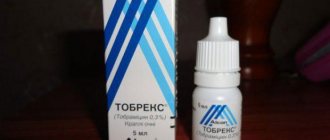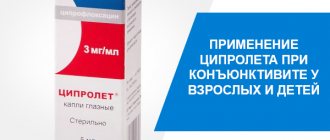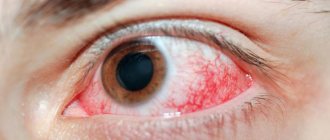Miramistin is used in almost all areas of medicine as an antiseptic drug. Is it possible to wash eyes with Miramistin? Ophthalmologists prescribe the drug to both children and adults for conjunctivitis, burns, ulcers, before surgery on the eyeball, and after surgery. For these purposes, there are dosage forms with a small concentration of the substance.
Medicinal properties and principle of action
Miramistin is a broad-spectrum antiseptic.
It has a detrimental effect on both gram-positive and gram-negative bacteria. Due to the activity of these microbes, eye inflammation often develops. Expert opinion
Ermolaeva Tatyana Borisovna
Ophthalmologist of the highest category, Candidate of Medical Sciences
This drug, acting on microbes, viruses and fungi, kills them along with the membrane, but the tissue of the eye itself is not affected.
Can I use it to wash my eyes? Yes, many experts strongly recommend washing the organs of vision with Miramistin, as it effectively relieves inflammation.
Have you washed your eyes with Miramistin?
- Regenerates damaged conjunctival tissue.
- The solution immediately acts on the pathogen; as the drug is used, the bacteria finally die.
- Affects local immunity.
- Adverse reactions in the form of allergies or irritations practically do not occur. Therefore, doctors often prescribe medicine to children and the elderly.
- The active substances of Miramistin are not able to be absorbed into the blood.
Thus, for conjunctivitis, the drug Miramistin can become an indispensable remedy. However, you should not use it without a doctor's prescription.
Miramistin is a broad-spectrum antiseptic. It has a detrimental effect on both gram-positive and gram-negative bacteria. Due to the activity of these microbes, eye inflammation often develops.
Reviews
Kondratyeva E.M., therapist: “Miramistin is a universal and affordable antiseptic. Active in the fight against many pathogenic microorganisms. It is used in various fields of medicine and is effective in the prevention of sexually transmitted diseases. Adverse reactions when using the drug are rare. I recommend adding this product to your home medicine cabinet!”
Marina, 34 years old: “For our family, Miramistin is the best remedy in the fight against germs, infections, bacteria. Helps with burns, scratches, inflammation, colds. Well tolerated by children. Almost tasteless. My sons sometimes think that I treat their neck with plain water. Even ears were treated with it. The drug is more expensive than chlorhexidine, but its wide spectrum of action and effectiveness fully justify the cost.”
Daria, 47 years old: “Miramistin is an excellent antiseptic and protector against developing inflammatory processes. I use it for a runny nose, for rinsing the mouth to prevent stomatitis, and even for gynecological purposes. Economical and easy to use. It has a minimal composition, which complex drops cannot boast of. This reduces the likelihood of adverse reactions. Can be used as a spray or applied to cotton wool directly from the neck. Suitable for pregnant, nursing and children. Effective as part of complex therapy for a variety of diseases.”
For different types of illness
Is it possible to rinse the eye with Miramistin? The manufacturer does not prohibit such use of the drug. But why are such actions needed? What is the effectiveness of an antiseptic when used in ophthalmology?
Miramistin solution has a wide spectrum of action. It is effective against various bacteria, fungi and viruses. Often, before prescribing a drug, ophthalmologists prescribe a culture for the patient. This analysis allows you to identify the pathogen, and the doctor, in turn, prescribes an effective medicine.
Since the declared antiseptic is effective against almost all microbes, it can be used even without preliminary analysis. There is a high probability that he will help you. Practice shows that patients use Miramistin to wash the eyes for conjunctivitis caused by gram-negative and gram-positive bacteria. The composition is also used for fungal diseases and viral infections of the organs of vision.
The drug can be used for the following types of conjunctivitis:
- Viral. Thanks to its composition, Miramistin effectively affects viruses that infect the conjunctiva. The medicine has a destructive effect on complex viruses, such as herpes or immunodeficiency virus, as well as those that are sexually transmitted.
- Bacterial. Miramistin has bactericidal properties. It is equally effective against both gram-positive and gram-negative organisms, as well as anaerobic and aerobic bacteria.
- Allergic. If conjunctivitis has developed due to allergies, in this case Miramistin is unlikely to help. But it happens that in advanced cases, a bacterial infection joins the allergy, resulting in purulent discharge from the eyes. That’s when the doctor prescribes Miramistin.
- Purulent. Purulent conjunctivitis is a direct indication for the use of Miramistin. Usually, already in the first days of using the medicine, a person feels an improvement, namely:
- Photophobia disappears.
- Itching and burning disappears.
- The sensation of the presence of a foreign object in the eye disappears.
- The pus may disappear completely or its discharge may decrease.
- Viral. Thanks to its composition, Miramistin effectively affects viruses that infect the conjunctiva. The medicine has a destructive effect on complex viruses, such as herpes or immunodeficiency virus, as well as those that are sexually transmitted.
- Bacterial. Miramistin has bactericidal properties. It is equally effective on both gram-positive and gram-negative organisms, as well as anaerobic and aerobic bacteria.
- Allergic. If conjunctivitis has developed due to allergies, in this case Miramistin is unlikely to help. But it happens that in advanced cases, a bacterial infection joins the allergy, resulting in purulent discharge from the eyes. That’s when the doctor prescribes Miramistin.
- Purulent. Purulent conjunctivitis is a direct indication for the use of Miramistin. Usually, already in the first days of using the medicine, a person feels an improvement, namely:
- Itching and burning disappears.
- The sensation of the presence of a foreign object in the eye disappears.
- The pus may disappear completely or its discharge may decrease.
How to use the solution correctly
Miramistin solution is truly capable of fighting almost all types of fungi, bacteria, viruses, including HIV. But in order for the medicine to be as effective as possible, without causing harm, it is important to use it correctly and not spray it at random.
It is recommended to treat the organs of vision with Miramistin as follows:
- Prepare drops, warm boiled water for cleansing and washing the eyes (can be replaced with weak tea leaves or chamomile decoction), cotton pads or clean linen napkins. Paper ones are not suitable, as they delaminate and leave fibers on the surface of the eye and mucous membrane.
- Wash your hands with soap, rinse thoroughly and wipe dry.
- Clear the eyes of purulent discharge and crusts. To do this, use a cotton swab dipped in warm water, chamomile infusion or tea leaves. Washing is carried out in the direction from the outer corner to the inner one. One tampon is used strictly for one eye.
- Next, you should tilt your head back, carefully pull back the lower eyelid and administer the drug in an amount of 2-3 drops. Even if only one eye is infected, Miramistin should be dripped into both eyes to prevent the spread of infection.
- After administering the eye drops, it is recommended to lie down or sit for a few more minutes with your head thrown back, pressing your fingertips on the corners of your eyes. This must be done to ensure that the medicine is correctly distributed and gets to where it should be.
The procedure is repeated three times a day. The course of treatment lasts until the symptoms of inflammation completely disappear.
Miramistin eye drops are recommended for use as a prophylactic agent before surgery on the visual organs, as well as after surgery to prevent infection of the wound and the growth of pathogenic microflora
Where should contact lenses not be stored?
While saline and eye drops are an undesirable but acceptable option for temporarily storing lenses, some products are strictly prohibited from being used for this purpose.
- Water.
Can contact lenses be placed in water overnight? This question interests many users, because in the absence of a solution, ordinary water is the most accessible remedy. However, manufacturers and ophthalmologists say that it contains a huge number of pathogens that settle on the lenses and can contribute to the development of eye infections. It is for this reason that you should not even rinse your lenses with water, either tap water or boiled water.
The only acceptable option is distilled water, but after it, optical products must be disinfected in any case.
- Saliva.
On Internet forums you can find the most unusual advice on the topic “What else can replace special liquids for storing lenses.” Some people advise using your own saliva: supposedly its composition is natural to the body and cannot harm the eyes. Doctors refute this myth and say that saliva contains a huge number of microbes that can cause infection.
- Hydrogen peroxide.
Many users reason like this: there are special peroxide cleaners for contact optics, which means hydrogen peroxide is suitable for storing lenses. Ophthalmologists explain that special cleaners contain hydrogen peroxide in small proportions. Also, after cleaning, the peroxide in these solutions is neutralized in a special way so as not to harm the eyes or cause a burn to the cornea. If you store your lenses in regular hydrogen peroxide and then don't rinse them thoroughly enough, you may end up with a serious chemical burn.
Medical point of view
So is it really possible to use Miramistin for the eyes? What do experienced doctors think about this? Doctors say that benzyldimethyl is indeed an excellent antiseptic. Many patients, not knowing the cause of eye disease, purchase antibiotic drops. But they are not always effective.
The manufacturer of the claimed product has long been producing a medication based on the same active ingredient, but specifically for the eyes. Its trade name is Okomistin. It cleanses the mucous membrane of gram-negative, gram-positive bacteria, anaerobes and aerobes. It has been proven that it is effective against fungi, chlamydia, viruses (including herpes), and adenoviruses.
Indications
The drug is most effective for various eye lesions caused by pathogenic microorganisms. In particular, it is worth highlighting the following:
- Fungi that penetrate the mucous membrane of the eyes mainly from the gastrointestinal tract.
- Streptococcal infections.
- Gonococci and Trichomonas.
- Intestinal infections.
- Various viruses.
- Chlamydia.
It is often necessary to use Miramistin in combination with other drugs that are aimed at eliminating various symptoms of the disease.
Most often, the medicine is prescribed for the following eye diseases:
- Uveitis.
- Conjunctivitis caused by bacteria, viruses or fungi.
- Allergic inflammation of the eyes.
- Chlamydia frolicking in the visual organ.
- Damage to the outer layer of the eyes.
- Ulcerative damage to the cornea.
- Burn of the cornea, thermal or chemical.
Expert opinion
Miramistin is also used to wash the eyes before surgery to prevent suppuration.
Many parents are interested in the question: is it possible to treat children with this drug and wipe their eyes with it? Experts unanimously say that Miramistin is not used to treat children under three years of age. However, in case of severe infection, doctors often recommend wiping the child’s eyes with this solution, which has less impact on the baby’s body.
Regarding other contraindications, the following can be identified:
- Pregnancy and breastfeeding. The drug is usually not prescribed, but if the doctor deems it necessary, in rare cases Miramistin is still prescribed.
- Personal intolerance to the active components of this medication.
The drug is most effective for various eye lesions caused by pathogenic microorganisms. In particular, it is worth highlighting the following:
- Fungi that penetrate the mucous membrane of the eyes mainly from the gastrointestinal tract.
- Streptococcal infections.
- Gonococci and Trichomonas.
- Intestinal infections.
- Various viruses.
- Chlamydia.
Mode of application
Is it possible to wash the eye with “Miramistin” during inflammation? Yes! Moisten a sterile swab with the drug and clean the organ of vision from purulent discharge. After this, drop 2-3 drops into each eye. Repeat the procedure three times a day. For children, doctors prescribe Miramistin for the eyes, 1-2 drops three times a day.
If you decide to use Okomistin, then it is injected into the conjunctival sac 1-2 drops up to 6 times a day. The manufacturer does not limit the period of use. It is permissible to use an antiseptic until recovery occurs.
"Miramistin" and "Okomistin" can be used for preventive purposes. The drugs are prescribed for surgical and diagnostic interventions. Start using solutions three days before the procedure. Inject 1-2 drops into each eye three times a day. After the manipulation, unless prohibited by your doctor, use the antiseptic for another 10 days. This will help avoid bacterial infection.
Is it possible to wash the eye with Miramistin if an injury occurs? Such manipulation is not only possible, but also necessary. If the mucous membrane is damaged, there is a high probability of complications, since pathogenic flora immediately enters the affected area. Wipe the injured area with a sterile cotton swab soaked in Miramistin or Okomistin solution.
Application in ophthalmology
Eye drops are produced in a solution of 0.01% of the active substance. Intended for the treatment of conjunctivitis of various origins (bacteria, viruses, fungi). The product is used for external use. Miramistin for conjunctivitis in adults has an anti-inflammatory effect, destroys pathogens, which leads to clearing of the serous film from the eye. A drug:
- eliminates burning sensation;
- itching;
- irritation;
- increased lacrimation.
This helps reduce inflammation and restore vision.
Miramistin should be dripped into the eyes for conjunctivitis, 2 drops no more than 6 times a day . Place drops in the inner corner, cover the eyelid and gently massage the eye with your finger to better distribute the medicine over the entire surface of the eyeball.
In the chronic form of conjunctivitis, the ophthalmologist advises rinsing the eyes with a remedy to prevent relapse of the disease after the main treatment if discomfort or hyperemia of the sclera is observed. To do this, apply the solution to a cotton swab and wipe the eyes from the inner edge to the outer.
Before starting treatment for conjunctivitis, you should consult your doctor, since Miramisin is effective in the initial stage of the disease. If doctors prescribed Miramistin for conjunctivitis as part of complex therapy, it means that the disease has entered the second stage of development, in which antimicrobial agents are used. In this case, before using eye drops containing an antibiotic, wash the eyes with Miramistin. The course of treatment is determined by the doctor, depending on the complexity of the disease.
Why should Miramistin not be used in ophthalmology?
Miramistin is a universal antiseptic, which has also been used in the treatment of pathologies of the organs of vision. It is used in two cases, and childhood is not a contraindication.
- Acute course of conjunctivitis. For inflammation of the eye mucosa, this drug helps reduce the intensity of pathological processes. It quickly destroys microbial colonies, which leads to recovery.
- Performing eye surgeries. During surgery, it is necessary to ensure sterility, so the mucous membranes are treated with an antiseptic. This is done both before and after the manipulation.
General principles of treatment of all types of conjunctivitis
For what reasons is preference given to Okomistin eye drops? Miramistin should not be used independently in ophthalmology, because this drug is, in principle, not intended for use for such purposes. It is necessary to replace one product with another because the Miramistin solution is inconvenient to dose.
Where can I put my lenses if I don't have solution?
You forgot to buy a new bottle of multifunctional solution on time, stayed overnight with friends, accidentally spilled your cleaner, were delayed somewhere due to bad weather - this is just a small list of situations when it is not possible to organize the storage of contact lenses according to all the rules.
Where can you temporarily put optical products in this case:
- Saline solution (ready or homemade).
- Artificial tear substitute drops.
Let us immediately note that none of the alternative options provides thorough disinfection of contact optics and can only be used as a temporary measure. As soon as possible, the lenses must be treated according to all the rules and dipped in a multifunctional solution. Only then can they be used safely.
Inflammation of the eyelid
Miramistin for styes of the eye is used to wipe the damaged eye. If a person has a red lump on his eyelid, then this is stye, which transforms into an abscess. To prevent this, if hyperemia and itching appear, you should immediately treat the damaged eyelid with Miramistin solution. To do this, soak a cotton pad in the liquid and wipe the inflamed area.
Use in pediatrics
The drug differs from other medications used in ophthalmology in that it does not penetrate the mucous membranes and is not accumulated by the body. Therefore, pediatricians treat conjunctivitis with Miramistin even in newborns. The disease is quite common in children, since it is a disease of dirty hands, and children often rub their eyes with their palms, thus causing infection.
Reaction and side effects
The patient may not be aware of individual intolerance to the active component of the drug. If, after the administration of Miramistin, the itching and redness of the mucous membrane intensified, swelling, pain, or stinging appeared, you should immediately rinse your eyes with warm boiled water and, if necessary, consult a doctor. If the listed symptoms are accompanied by skin rashes, itching, swelling of the extremities, it is recommended to take an antihistamine and also consult a doctor. You should not continue the course of treatment with Miramistin.
If the drug comes into contact with the mucous membranes of the eyes, nose or mouth of a newborn or a child under three years of age, you should immediately rinse the eyes, nose or mouth with boiled water and consult a doctor as soon as possible.
In order for a person to be prepared to use the drug Miramistin, it is necessary to know what sensations may arise when using it. Firstly, at the beginning of its use, there is a feeling of discomfort in the eye area, which is manifested by tingling or slight tingling. This feeling goes away literally after 20-30 seconds.
To avoid such allergic reactions, it is advisable to first check how the body reacts to Miramistin. To do this, apply a few drops of the medicine to the elbow and wait a few minutes. If there is no reaction, then you can continue to use the product as directed.
Expert opinion
If a person feels itching and burning that does not go away for a longer period, then most likely he has developed an allergy to the components of the substance.
It is not recommended to exceed the indicated dosage regimens or doses prescribed by a specialist, although no cases of overdose have been recorded.
Scientists allow that in case of a severe overdose, the active substance enters the bloodstream.
In such cases, you need to stop using the drug or significantly reduce the dose. In parallel, ophthalmologists in such cases can prescribe medications that contain calcium.
Although children should not have access to medicines, a child may inadvertently ingest medicine. In such cases, you need to remember that this antiseptic can destroy both beneficial and harmful intestinal microflora. This can provoke dysbacteriosis.
If less than 30 minutes have passed since swallowing, give the child plenty of water and induce vomiting. After this, give activated carbon in the required dosage. If more than half an hour has already passed, it is better to call an ambulance.
Side effects of Miramistin
If you begin to worry about allergic manifestations, immediately notify a specialist.
The drug can cause an allergic reaction, which is characterized by local inflammation, redness and swelling.
Also, within half a minute after instillation, an unpleasant burning sensation may be observed, which should not persist longer. In this case, discontinuation of the drug is not required and this effect is considered normal.
If adverse events persist longer and are more pronounced, you should stop the drug and immediately consult a doctor for a decision on replacing it.
In what cases is the drug used?
For conjunctivitis and other infections of the organs of vision, the doctor may prescribe Miramistin in the form of a solution of the lowest concentration - only 0.01% of the active ingredient. The solution contains:
- benzyldimethyl-myristoylamino-propylammonium sodium chloride monohydrate as the main active substance;
- purified water as an auxiliary component.
The drug is a colorless, odorless and sediment-free liquid. If you shake the bottle, the solution will foam. Bottles of 5 and 10 ml are available for sale.
Instructions for use recommend using Miramistin eye drops for the following pathologies and conditions:
- introduction of infection of any nature – bacterial, viral, fungal;
- inflammation caused by allergies;
- chlamydia of the organs of vision;
- injuries to the external part of the organs of vision;
- uevitis;
- ulcerative lesions of the cornea;
- burns of the cornea of any nature - chemical or thermal.
Also, washing with Miramistin is recommended in preparation for surgery and after it to prevent inflammation and suppuration of the eyes. Is it possible to wash the eyes of a child, and especially a newborn, with Miramistin? This is a common question from patients. After all, every parent wants to cure their baby quickly, so that just one drop and everything goes away. However, in this case, Miramistin is not suitable; it is not used to treat children under three years of age.
Other contraindications to the use of this medicine:
- During pregnancy and breastfeeding;
- individual intolerance to the active component of the drug.
As an alternative in this case, you can use Furacilin or Chlorhexidine. They are less aggressive; these products can be used to wash a child’s eyes from birth. But they do not act as effectively as Miramistin.
The drug Miramistin contains the following components:
- The main active ingredients are benzyldimethyl and ammonium chloride monohydrate.
- Purified water is also added to the preparation.
The liquid is poured into plastic containers with a volume of 50 to 500 ml. It is transparent, in some cases it may have a yellowish tint. Cloudiness is unacceptable.
Is it possible to store contact lenses in saline solution?
Saline solution is a 0.9% aqueous solution of sodium chloride. It can be purchased ready-made at any pharmacy or prepared independently from 100 grams of distilled water and 0.9 grams of ordinary salt. The second option is not recommended for people with highly sensitive eyes or a tendency to allergic reactions.
The composition of the prepared saline solution is close to special means for cleaning lenses. However, it lacks a number of enzymes and bactericidal components with disinfectant properties.
Before removing lenses, prepare a storage container and sterilize it. Then pour in enough saline solution to completely cover the optical products. Place the lenses in the container and close the lid tightly.
Preparation
Before using the drug, you need to make sure that it has not expired and that the liquid inside the bottle is not cloudy. This is very important, as there is a risk of introducing additional infection.
It is imperative to identify the nature of inflammation of the eyes and conjunctiva, since in most cases with an allergic lesion this remedy is powerless.
Before using the product, wash your hands thoroughly and clear your eyes of purulent crusts; for this you can use boiled water or brewed tea. A separate swab is taken for each eye.
Expert opinion
You should not use Miramistin alone to treat conjunctivitis; you may need an integrated approach to therapy.
Miramistin for prevention
In ophthalmology, the drug is used for preventive purposes before or after operations:
- Before any surgical intervention, 3-4 drops of Miramistin are dripped up to 5-6 times a day. Mainly used before cataract, glaucoma, and cataract surgeries. Many patients feel relief even after the first days of using the medicine.
- After surgery on the eyes, it is recommended to drip Miramistin 2-3 drops 4-6 times a day for another 12-14 days. It was particularly effective in transplanting parts of the eye. It reduces the risk of infection and helps the transplanted element to take root quickly.
How to use Miramistin solution
The solution is ready for external use. For wounds and burns, apply with gauze or cotton wool to the affected area of the skin. The frequency of the procedure is 2-3 times a day for 3-5 days.
For the treatment and prevention of gynecological diseases, a tampon is soaked in an antiseptic (up to 50 ml), which is inserted into the vagina for 2 hours. The course of therapy is 5-7 days.
To prevent STDs, Miramistin is administered into the urinary canal using a urological applicator in the following dosage:
- men - 3 ml;
- women - 2 ml;
- separately in the vagina - 10 ml.
The solution is ready for external use. For wounds and burns, apply with gauze or cotton wool to the affected area of the skin.
After introducing the antiseptic, the applicator is carefully removed, and the solution is delayed for 2-3 minutes. It is recommended to refrain from urinating for 2 hours. Prevention of STDs is effective if the procedure is carried out no later than 2 hours after sexual intercourse. Treatment of inflammatory diseases of the urethra is carried out in a similar way with a frequency of administration of the drug 1-2 times a day for 1.5 weeks.
For ENT diseases and for dental purposes, Miramistin is used to irrigate the affected area using a special sprayer or rinse. The procedures are repeated 3-4 times a day for 4-10 days. The volume of a single irrigation is 10-15 ml. For children under 6 years of age, the recommended dosage of antiseptic is reduced by 3 times, and for children under 14 years of age - by 2 times.
The exact duration of treatment and dosage of the drug should be checked with your doctor.
For diabetes
Poor circulation in diabetics is the cause of delayed wound healing. Even the slightest scratch needs immediate treatment with an antiseptic, for which Miramistin is excellent. In the absence of symptoms of inflammation (fever, redness or swelling), auxiliary drugs are not required. If complications occur, a doctor’s consultation and additional treatment measures are required.
Features of use in adults
As a powerful antiseptic, Miramistin can prevent complications after surgery. This drug suppresses the growth of pathogenic microflora and stimulates tissue regeneration. If the operation involves implantation, Miramistin will speed up the adaptation process and prevent implant rejection.
It is used in preparation for surgery and after surgery as follows:
- three days before surgery, 2-3 drops are administered into each eye three times a day;
- after the operation, the drug is used in the same dosage, also three times a day, for two weeks, even if there are no atypical symptoms.
Miramistin eye drops not only prevent infection of the organs of vision after surgery and accelerate the process of scar healing and tissue restoration. This remedy also relieves postoperative swelling, reduces itching and discomfort, and the sensation of a foreign body in the eye. After the operation, it is strictly forbidden to touch your eyes with your hands, especially scratching and rubbing them. Miramistin will help you cope with the difficult postoperative period without complications and stress.
For injuries or burns of the cornea, Miramistin drops are prescribed for two purposes:
- prevent the development of secondary bacterial infection;
- accelerate the healing of postoperative scars and tissue restoration.
The method of administration is the same: the drug is administered in an amount of 2-3 drops into each eye three times a day. The course of treatment lasts until the ulcer or injury is completely healed. After the first instillation, the patient will feel relief:
- pain and discomfort will decrease;
- tear production will decrease;
- photophobia will go away.
A lasting effect and noticeable improvement will be achieved on day 2-3 of therapy. For cataracts, ophthalmologists sometimes prescribe Miramistin drops as a means of reducing the area of lens opacification.
Miramistin should be instilled into the conjunctival cavity - 4-5 drops into each eye 1-2 times a day. After instillation, you need to lie down for a while with your head thrown back. Even if one eye is inflamed, instillation is carried out in both visual organs.
In the absence of complications, the maximum course of use of the drug is 10 days.
If during this period the desired result was not achieved, the medicine is replaced with a similar one.
Indications for use
Miramistin is indicated for:
- the presence of an inflammatory phenomenon in the eyes;
- tissue damage (serves to accelerate regeneration);
- sensation of a foreign body in the eyes;
- increased production of tears;
- reducing the likelihood of complications at the preparatory stage for surgery;
- microbial, viral and fungal infections of the eye;
- keratitis;
- inflammation of the conjunctiva;
- chlamydia infection;
- iritis and iridocyclitis;
- blepharitis and blepharoconjunctivitis;
- corneal burns;
- uveitis;
- eye injuries;
- suppuration in the anterior chamber of the organ of vision.
Use in children
Miramistin is prescribed to children over 3 years of age only for conjunctivitis. In special cases, the medicine can also be used in younger patients. Sometimes doctors are forced to prescribe Miramistin for infectious conjunctivitis. All dosages and duration of treatment are determined by an ophthalmologist. The average dosage for children is 6 drops per day. It is forbidden to use the medicine for more than 10 days.
Miramistin for eye treatment is produced in solution in bottles of 5, 10, 100 ml. The concentration of the active substance (Benzyldimethyl-myristoylamino-propylammonium chloride monohydrate) is 0.01%. The solvent is purified water. Small bottles of 5 and 10 ml are produced under the name Okomistin. The concentration of the substance is the same, only dosing the drug is more convenient.
What is it used for?
For chlamydial infection of the organs of vision in children and adults, Miramistin drops help to quickly get rid of symptoms such as:
- photophobia;
- lacrimation;
- discharge of pus;
- swelling and redness.
The drug is administered 2-3 drops into each eye up to five times a day for acute chlamydial infection. After two or three days, the frequency of instillations can be reduced to three, and so on until complete recovery. Miramistin can be used to treat chlamydia in children under one year of age after consultation with a doctor, if other drugs have not given the expected effect and the infection progresses. Treatment of infants with this drug is carried out strictly under medical supervision.
The drug is prescribed for inflammation of the cornea of the organ of vision, as well as as a prophylaxis before and after surgery. Before using the drug, you should consult with an ophthalmologist. The doctor prescribes Miramistin eye drops for the following ophthalmological ailments and situations:
- infectious viral, bacterial, fungal eye diseases;
- keratitis;
- conjunctivitis;
- ophthalmochlamydia;
- iridocyclitis;
- uveitis;
- blepharoconjunctivitis;
- cloudiness, burns and ulcers of the eye cornea;
- keratouveitis;
- prevention of pre- and postoperative inflammation processes accompanied by purulent discharge;
- visual injuries;
- purulent processes in the anterior part of the eye.
Can lenses be put in eye drops?
Another acceptable alternative to multifunctional solutions is moisturizing eye drops. They are usually used to treat dry eye syndrome or to improve user comfort while wearing lenses. Such drops do not disinfect optical products, but will help preserve their structure and protect them from drying out.
Some users put their optical products in Taufon or other drops. This option cannot be called optimal. More suitable - “Visine Pure Tear” and analogues.
What are the advantages
Today, pharmacies offer a number of different antiseptic and antibacterial eye drops. Why do many doctors and patients prefer Miramistin? The thing is that this drug has three advantages, which are at the same time the most important criteria for an effective ophthalmic drug:
- Increases local immunity - important in the treatment of viruses and fungi, when the slightest favorable factor causes a relapse of the disease.
- Accelerates tissue regeneration - is of great importance for burns, injuries, corneal ulcers, and in the postoperative period.
- Acts directly on the causative agent of the disease, regardless of the nature of its origin.
The last point can be considered one of the most important. In case of a bacterial infection, it is often not possible to select the optimal medicine the first time, since the doctor cannot immediately determine the type of pathogenic microflora that attacked the organs of vision. Bacterial seeding takes from four days to three weeks. All this time, the patient is forced to make do with a universal antibacterial agent with a wide spectrum of action, often it turns out to be ineffective, and the disease continues to progress. Or it gives a number of serious side complications.
This cannot happen with Miramistin. It helps where other means are powerless, even if the doctor and patient do not know what it is - a fungus, a virus or bacteria. Thus, eye drops easily and quickly relieve complex combined infections of the organs of vision, including chronic ones.
What else is important to know
Immediately after administration of the drug, itching, burning, and tingling in the eye may occur. This is a natural reaction that should go away on its own after 5-10 minutes. If this does not happen, and the discomfort increases, most likely the patient has hypersensitivity to the active component.
If the patient uses contact lenses, then before administering the drug they need to be taken out, drops injected, wait fifteen minutes, then put the contact lenses back on - if there is really an urgent need for this. Ophthalmologists recommend that you refrain from using devices for contact vision correction during treatment with any ophthalmic drugs.
When Miramistin is used simultaneously with other antibacterial drugs, the therapeutic effect mutually enhances.
Summary: Miramistin eye drops are a powerful antiseptic, although in comparison with other pharmaceutical forms this solution has a minimal concentration of the active component. The drug is active against almost all bacteria, fungi and viruses, including chlamydia, herpes and HIV.
In addition, Miramistin promotes scar healing and accelerates tissue regeneration after injury, burn or surgery. The drug can also be used in the complex treatment of cataracts. Drops are usually well tolerated, but, nevertheless, you should not start a course of treatment on your own; consultation with a doctor is necessary.
There are many ophthalmological drugs available on the pharmaceutical market. But not many of them can cope with infectious eye inflammation. The drug Miramistin stands out favorably in this list. This remedy effectively helps with conjunctivitis, as it has several actions simultaneously - it serves as an antiseptic, relieves inflammation, has an antimicrobial effect, and finally, strengthens local immunity.
special instructions
When administering the drug by drip into the eyes, urethra or bladder, it is recommended to avoid potentially dangerous activities, driving vehicles and operating complex machinery for several hours.
During the treatment of eye diseases, it is recommended to stop wearing contact lenses. If this is not possible, the corrective device is removed before using Miramistin and put on 20-30 minutes after the procedure.
The drug is intended for local use. Avoid getting the product into the gastrointestinal tract.
Prescription for children
The drug is actively used in pediatrics, as it is non-toxic, has no contraindications and rarely causes adverse reactions. When treating young patients under 3 years of age, specialist supervision is required.
Therapy for children under 1 year of age is possible only as prescribed by a doctor and under his strict supervision.
Therapy for children under 1 year of age is possible only as prescribed by a doctor and under his strict supervision.
Use during pregnancy and lactation
Resorption of the drug is low, so its local use according to indications is permissible during pregnancy and lactation. Monitoring by a doctor is required throughout the course of treatment.











